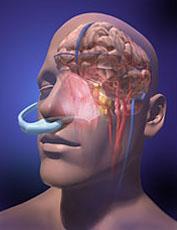
August 18, 2010 - A new portable system which cools the brain via the nasal cavity may improve survival following cardiac arrest compared with standard care procedures, particularly when cardiopulmonary resuscitation (CPR) and cooling are initiated early.
Results from a recent study showed that the RhinoChill Intra-Nasal Cooling System enabled brain temperature to reach target several hours earlier than patients cooled in the emergency room. It is widely recognized that the sooner brain temperature can be reduced, the better the chances of minimizing long-term damage.
The study, published online in the prestigious peer-reviewed journal Circulation, is the first to evaluate cooling using this system in a randomized protocol conducted in the field and during the arrest. The Pre-Resuscitation Intra-Nasal Cooling Effectiveness (PRINCE) study involved 200 patients with witnessed cardiac arrest across 15 locations in Belgium, Germany, Italy, Czech Republic and Sweden, where CPR had been initiated within 20 minutes of collapse.
Patients were randomized to either intra-nasal cooling with RhinoChill along with standard advanced cardiac life support (ACLS) care or ACLS alone until they were either resuscitated or reached hospital, at which stage patients in both groups were cooled.
"In this study, early cooling of the brain combined with early CPR favorably affected outcomes, irrespective of rhythm," commented PRINCE lead investigator, Dr. Maaret Castren of the Department of Clinical Science and Education, Karolinska Institute, Stockholm, Sweden and the Department of Emergency Medicine, Sodersjukhuset. "We believe that this study demonstrates that making every attempt to initiate both CPR and intra-arrest cooling as early as possible in the resuscitation process should be adopted."
Results showed that the target tympanic temperature of 34 degrees Celsius, used as an approximation of brain temperature, was reached three hours earlier in the group receiving pre-hospital cooling with RhinoChill.
Target core body temperature was also reached two hours earlier. Among patients surviving as far as hospital admission, 47 percent of patients who were cooled survived to discharge, compared with only 31 percent of those who had not been cooled. Survival rates in the 75 percent of patients who received CPR within ten minutes of collapse were 59 percent and 29 percent respectively.
Thirty-seven percent of those cooled intranasally during the arrest survived neurologically intact, compared with only 21 percent of those not cooled in the field. Neurologically intact survival rates in patients who received CPR within 10 minutes of collapse were 46 percent and 18 percent respectively, a very significant difference.
In an accompanying editorial to the PRINCE study published in Circulation, Lance Becker, M.D., from the University of Pennsylvania observes that, "Although the numbers are too small to reach significance, they provide some tantalizing cooling rates and survival trends that suggest that improved outcomes from intra-arrest nasal cooling may be found in a larger clinical trial."
He also commented, "A strength of this approach [RhinoChill] appears to be its relative noninvasiveness and ease of administration. It may prove an ideal device for the emergency medical services setting."
The RhinoChill Intra-Nasal Cooling System uses a noninvasive nasal catheter to spray a rapidly evaporating coolant liquid into the nasal cavity. This large nasal cavity is a heat exchanger and lies right under the brain. The system's portability and ease of use mean that cooling of the brain can be initiated much sooner after a cardiac arrest than with traditional devices, which cannot be used until the patient reaches the hospital.
The RhinoChill System received CE mark approval for marketing in European Union countries in December 2007. It is currently planned to commence launches in selected European markets from October 2010. The RhinoChill System is not for sale in the United States.
For more information: www.benechill.com


 April 24, 2024
April 24, 2024 








